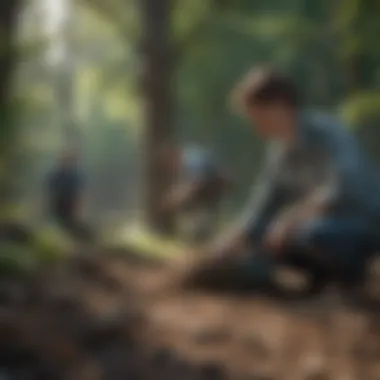The Positive Environmental Impact of Trash Collection


Nature Topic Overview
Trash collection is often seen as a mundane task, yet it has vital implications for our environment. The act of collecting trash plays a significant role in maintaining clean and healthy ecosystems. When trash is picked up from natural areas, it reduces pollution. This, in turn, helps protect wildlife and promotes biodiversity. Simply put, cleaner environments lead to healthier plants and animals. By understanding the importance of trash collection, children can learn to appreciate nature and their role in its preservation.
Fun Facts and Trivia
Here are some interesting facts about trash and its impact:
- Every year, millions of tons of plastic end up in the oceans, harming sea creatures.
- A single plastic bag can take up to 1,000 years to decompose.
- Up to 90% of marine birds have plastic in their stomachs.
Engaging visuals, like infographics, can help illustrate these facts and encourage discussions among young learners. Adding interactive elements like quizzes can enhance their learning experience.
Wildlife Explorations
Different animal species are affected by our trash habits. For example, turtles often mistake plastic bags for jellyfish. This leads to harmful effects on their health. Additionally, birds may ingest small pieces of plastic, which can be fatal. Protecting these animals starts with understanding their habitats.
Did you know? Some plants are specially adapted to grow in nutrient-poor soils. These plants help restore damaged ecosystems by improving soil health.
Environmental Awareness
It is essential for children to grasp the implications of trash on nature. Conservation and sustainability begin with small actions, like reducing waste and recycling. Here are some ways young people can contribute:
- Participate in local clean-up events.
- Encourage recycling at home and school.
- Use reusable bags and bottles instead of single-use items.
"Taking care of our environment is not just for adults. Every small action counts."
DIY Nature Activities
Engaging with nature through hands-on activities can deepen understanding. Here are a few ideas:
- Nature Scavenger Hunt
Create a list of items to find outside, like leaves, rocks, or flowers. - Crafts from Recyclables
Use empty bottles or cardboard to create art projects. Encourage creativity! - Garden Exploration
Start a small garden. Plant native flowers or vegetables. Observe how wildlife interacts with them.
These activities help children connect with nature. It teaches responsibility not just towards the environment but also towards their communities.
Such a narrative can foster deeper understanding and appreciation for environmental efforts among the younger audience. Through education, they can learn the value of trash collection and its positive impacts on our ecosystems.
Understanding Trash and Its Impact
Understanding trash and its implications is crucial for grasping the significance of trash collection. The world is filled with various types of waste, and how we handle it directly affects the environment. For young minds, knowing the impact trash has on nature teaches valuable lessons about responsibility and care for our surroundings.
When people pick up trash, they contribute to cleaner air, soil, and water. It's not just about sight; it’s about health too. Litter can attract pests and spread diseases. For children, this knowledge can spur interest in their environmental role, encouraging them to care about their local parks, beaches, and streets.
Taking action by engaging in trash collection promotes not only environmental awareness but also community spirit. As children and adults gather to clean up their neighborhoods, bonds form. This unity fosters understanding that we, as individuals, have a shared responsibility, and each action, no matter how small, matters.
Definition of Trash


Trash encompasses items we discard because they are deemed useless. It includes anything unwanted, regardless of its origin. Understanding what constitutes trash is the first step towards responsible disposal and recycling. Trash can be found in households, workplaces, and public spaces. Learning this definition helps children identify trash around them.
Types of Trash in the Environment
Trash isn't uniform; it consists of various types, each with its traits and effects on the ecosystem.
- Plastic Waste: One notable type of trash is plastic waste. This type remains in the environment for hundreds of years. It can break down into microplastics, which harm wildlife. Plastic is lightweight and cheap, making it popular in many products. However, its longevity poses a danger to birds and aquatic animals that might ingest it.
- Organic Waste: Another important waste type is organic waste. This includes food scraps and yard waste. Unlike plastic, organic materials can decompose naturally. They can also be turned into compost, enriching soil and reducing the need for chemical fertilizers. This organic recycling helps close the loop in the waste system, promoting healthier ecosystems.
- Metals and Glass: Metals and glass are another category of trash. These materials are recyclable, which is a significant advantage. They can be melted down and remade into new products. However, if discarded carelessly, they can take many years to decompose. Teaching children about recycling metals and glass can encourage sustainable practices early in their lives.
Effects of Trash on Ecosystems
Trash disrupts the balance in ecosystems. Animals may ingest or become entangled in waste, leading to injuries or fatalities. Additionally, litter can pollute water bodies, affecting aquatic life and making water unsafe for human use. Furthermore, the presence of trash can deter people from visiting parks and natural reserves, leading to a decline in the well-being of these spaces. Educating the younger generation on these issues is critical, as it empowers them to become change-makers in their communities.
Benefits of Picking Up Trash
The act of picking up trash carries significant advantages that impact our environment. When we clean up litter, we do not merely make our surroundings look better; we also foster a healthier ecosystem and empower communities. Understanding these benefits is essential for encouraging more individuals, especially children and families, to participate in trash collection efforts. This section will explore the crucial elements of how cleaning up trash enhances environmental health, prevents pollution, and promotes biodiversity.
Enhancing Environmental Health
Maintaining a clean environment is vital for the well-being of various living organisms. When trash is removed from public spaces, it prevents bacteria and other harmful pathogens from breeding. Litter can attract pests, which further distribute diseases. For instance, rodents and insects thrive in trashy environments, endangering human health and wildlife. By just picking up trash, we help create habitats that are safe for both plants and animals.
Moreover, reducing litter contributes to cleaner air and water. Trash on the streets can wash into drainage systems, leading to water pollution that endangers aquatic life. Clean water sources are important not only for the ecosystem but also for human consumption. Thus, engaging in trash collection leads to improved health for everyone.
Preventing Pollution
Trash collection plays a critical role in pollution prevention. When litter accumulates in our communities, it becomes a source of pollution that affects various areas, such as land, water, and air. For example, plastic waste can take hundreds of years to decompose, releasing toxins into the ground and waterways. This pollution can harm wildlife, disrupt food chains, and ultimately affect human health through contaminated resources.
By taking the time to remove trash, we reduce the volume of waste that contributes to pollution. Citizens who participate in clean-up efforts help to create awareness about responsible waste disposal and recycling practices, which is essential in minimizing environmental impact.
Promoting Biodiversity
Promoting biodiversity is another significant benefit of trash collection. Many species rely on clean environments to thrive. When trash is eliminated from habitats, it restores the natural ecosystem balance and provides a healthier space for diverse species to flourish. For instance, animals are likely to reproduce and live in environments devoid of trash, which is essential for maintaining ecological integrity.
Communities that prioritize clean-up activities often see an increase in flora and fauna variety. As juvenile learners become involved in these initiatives, they learn the importance of habitat preservation and the role every species plays in the ecosystem. This understanding fosters a connection to nature and encourages a lifelong commitment to environmental stewardship.
"Our actions today can ensure that future generations inherit a healthier planet."
By recognizing these benefits, we can inspire a culture of responsibility toward our environment. Clean-up events do not just improve local areas; they cultivate communities that value their surroundings, ensuring a better future for all.
Engagement and Responsibility
Engagement and responsibility in trash collection are essential components when considering our collective environmental obligations. Trash collection is not just the act of picking up litter; it fundamentally shapes our attitudes toward the environment. Involving communities in cleanup efforts fosters a sense of ownership and connection to local ecosystems. When individuals participate in these activities, they gain a clearer understanding of how waste impacts nature and society.
Communities that actively engage in trash collection demonstrate their commitment to preserving natural beauty. This involvement can lead to tangible improvements in local environments, such as cleaner parks, rivers, and streets. Furthermore, community initiatives often inspire others to take part, leading to a ripple effect of environmental stewardship.
Community Involvement
Community involvement is a powerful aspect of effective trash collection practices. This can manifest in various ways, such as organized clean-up events, school programs, or local initiatives. These gatherings do more than simply clean areas; they unite people with a common goal, fostering friendship and teamwork.


Here are some benefits of encouraging community involvement in trash collection:
- Shared Responsibility: When a community bands together, the burden of environmental care is shared. Each participant contributes, lightening the load for all.
- Awareness Raising: Interacting in these events raises awareness of waste issues at the local level. Participants often learn about the types of trash commonly discarded and how they can minimize their own waste.
- Social Change: Collective efforts can lead to changes in local policies. When communities show they care about their environment, they may gain attention and support from local officials to improve trash management systems.
Fostering a Sense of Responsibility in Children
Teaching children about the environment and the importance of trash collection is imperative. Young learners are the future stewards of our planet. By involving them in trash clean-up activities, they develop a lasting sense of responsibility towards nature.
When children participate in these tasks, they build valuable skills, including:
- Understanding Consequences: By seeing the impact of trash in their surroundings, kids learn what happens when waste is not managed properly.
- Value of Leadership: Children who engage in trash collection often take on leadership roles during community events. This builds confidence and encourages them to lead similar efforts in the future.
- Environmental Advocacy: Early involvement can cultivate lifelong advocates for the environment. These children grow up understanding the significance of care for the Earth and may choose careers or hobbies aligned with this value.
By nurturing these principles from a young age, we will foster a generation that prioritizes environmental health and responsibility. Just as a clean environment benefits everyone, ensuring children understand their role is crucial to ensuring our planet's future.
Educational Value of Trash Collection
Trash collection is not just about cleaning up litter; it is an excellent educational opportunity. Engaging in trash collection activities introduces children to important environmental concepts. They learn about the impact of waste on our ecosystems and the necessity of clean surroundings. By experiencing this process firsthand, young learners gain a sense of responsibility toward their local environment.
One major educational benefit is the promotion of teamwork and cooperation. When children engage in clean-up projects, they work together toward a common goal. This fosters communication skills and strengthens social bonds. Furthermore, children will discover how their small actions lead to larger changes in their communities.
In addition to teamwork, trash collection also serves as a platform for teaching about biodiversity. While picking up trash, students can learn how different types of waste affect local wildlife and plants. Understanding the link between human activities and environmental health prepares children to think critically about their choices and promotes sustainable habits.
Learning through Action
Learning through action makes environmental education tangible. When children actively participate in trash collection, they move beyond the theoretical knowledge. They see the effects of trash in their local parks, beaches, or neighborhoods. This real-world connection enhances their understanding of waste management.
While participating in trash clean-ups, children notice the different kinds of waste items, such as plastics, metals, and organic materials. They begin to comprehend that not all waste is created equal. This awareness encourages them to think about recycling and waste reduction strategies. Engaging in such hands-on activities allows for insights that textbooks alone cannot provide.
"The best way to learn is by doing. By actively participating, children experience the consequences of trash and the importance of keeping their surroundings clean."
Understanding Waste Management
Understanding waste management is crucial for young learners. It identifies different waste categories and teaches how they can be handled. Trash collection serves as an entry point for discussing waste management principles.
Children can learn about:
- Recycling: They discover how recyclable materials like paper and plastic can be processed and reused.
- Composting: Engaging with organic waste teaches them about composting and how it enriches soil.
- Landfills: A discussion on what happens to non-recyclable waste highlights the need to reduce and manage waste better.
These knowledge components provide children insight into global waste issues. Understanding how waste is handled locally and globally encourages environmental stewardship. The more children know about waste management, the better equipped they are to contribute positively to their communities.
Practical Tips for Young Learners
When it comes to cleaning up our environment, young learners play a vital role in making a significant difference. Teaching children the importance of trash collection not only nurtures their connection with nature but also instills lifelong values of responsibility and stewardship. Understanding how to effectively organize clean-ups and consider safety is fundamental for these young environmentalists.
How to Organize a Clean-Up
Organizing a clean-up does not have to be a daunting task. Here are steps that young learners can follow:


- Choose a Location: Select a place that needs cleaning. This could be a local park, beach, or neighborhood area. Make sure it is safe for children and accessible.
- Gather Supplies: Collect necessary supplies. Use gloves, trash bags, and recycling bins. Each participant should have safety gear to protect themselves while working.
- Set a Date and Time: Decide when to hold the event. Consider the weather and choose a time that works for everyone.
- Invite Friends or Family: Encourage children to invite friends or family to join. The more people, the more fun and effective the clean-up will be.
- Provide Guidance and Education: Before the clean-up starts, explain to participants why this activity is essential. Discuss the impact of trash on the environment and the importance of proper disposal.
- Divide Responsibilities: Organize participants into smaller groups to cover more ground. Assign specific areas to each group so that everyone is included and aware of their tasks.
- Engage in Friendly Competition: Turn the clean-up into a friendly competition. Set goals like the most trash collected or the most creative recycling solution to motivate participants.
- Celebrate Your Success: After the clean-up, celebrate the collective efforts. Discuss what everyone learned and consider sharing the accomplishment with the community to inspire others.
Safety Considerations
Safety is critical during any clean-up activity. Here are key considerations to keep in mind:
- Wear Protective Gear: Gloves should be worn to avoid cuts and diseases. Encourage participants to wear closed-toe shoes to protect their feet.
- Monitor Young Children: Ensure that children are supervised at all times. Designate adults to oversee smaller groups to keep everyone safe.
- Know What to Avoid: Teach children what types of trash to avoid, such as sharp items or hazardous materials. If unknown items are found, ask an adult to handle them.
- Stay Hydrated and Take Breaks: Cleaning can be tiring. Remind participants to drink water and take breaks when needed.
- Emergency Preparedness: Have a first aid kit available. Make sure someone with basic first aid skills is present in case of minor injuries.
Organizing a clean-up can be a fun and educational experience. It not only helps the environment but also teaches young learners about teamwork and responsibility.
In summary, by carrying out these practical tips, young learners can effectively engage in trash collection activities. This involvement not only instills a sense of duty towards the environment but also creates opportunities for learning and growth.
Global Perspective
The global perspective on trash collection highlights how waste management is not only a local issue but a global challenge requiring collective action. Understanding the impact of trash on the environment can help young people grasp the significance of their roles in this larger context. It draws attention to how trash collection efforts can vary across different regions and the methods communities use to handle their waste.
In many places, improper waste disposal affects both human health and wildlife. For example, in cities like Accra, Ghana, and Jakarta, Indonesia, trash can block drainage systems, causing flooding and spreading disease. The accumulation of trash in oceans creates hazards for sea creatures. It’s crucial for learners to recognize these health risks and environmental challenges.
Participating in trash collection activities locally can directly benefit ecosystems around the world. When children and adults work together, they not only clean up their own neighborhoods but also contribute to broader efforts in addressing waste issues globally. Awareness and participation can lead to meaningful changes that reflect a commitment to preserving our planet.
"In every corner of the globe, trash is an issue, and by taking action, we weave together a fabric of global responsibility."
Trash Issues Around the World
Trash issues manifest in various forms throughout the world. Different countries face unique challenges that greatly affect their environments. In many cases, developing nations struggle with waste management due to rapid urbanization and insufficient infrastructure. The following points outline some notable examples of trash issues:
- Plastic Pollution: Countries like China and India have high levels of plastic waste in rivers and oceans, causing harm to aquatic life.
- E-Waste: Electronic waste, particularly in places like Nigeria, poses significant environmental threats as improper handling can release toxic substances.
- Landfill Overflows: Places such as the United States and some European countries deal with overflowing landfills, contributing to air and groundwater pollution.
Understanding these issues helps children see how interconnected our actions are.
Global Initiatives for Trash Collection
Numerous global initiatives have been launched to address trash collection and promote environmental responsibility. Some significant collaborations include:
- The Ocean Cleanup: This nonprofit organization focuses on developing advanced technologies to remove plastic from the world's oceans.
- The Clean Up the World Campaign: This initiative encourages communities to actively clean their environments and take responsibility for local waste management.
- The Earth Day Network: Organizing events each year, it mobilizes millions worldwide to clean up and preserve local communities.
These initiatives illustrate how community action can drive global change. Schools encourage students to partake in international clean-up days, fostering teamwork and accountability. Encouraging young learners to get involved in such activities helps them recognize their potential impact on a global scale.
In summary, by examining trash issues around the world and engaging with global initiatives, children can develop a deeper understanding of environmental stewardship. It reveals how collective actions, even small ones, have the power to inspire significant change across communities and nations.
Culmination
Summarizing the Importance of Taking Action
Taking action through trash collection is fundamentally about responsibility. It reinforces foundational concepts of environmentalism. When young people participate in these activities, they learn valuable lessons about how their actions can affect the world around them. Each piece of trash removed contributes toward cleaner waterways and parks, enhancing overall environmental health.
A few key benefits include:
- Improved Ecosystems: Removing trash helps restore natural habitats, allowing for wildlife to thrive. Excessive waste can disrupt food chains and lead to the decline of various species.
- Community Engagement: Trash collection encourages community involvement. Seeded within these interactions is the chance to build relationships with neighbors. It turns individuals into collective stewards of the environment.
- Education: Engaging in trash removal offers rich educational experiences. Children start to understand waste management and recycling concepts, developing habits they can carry into adulthood.
"Every small action counts. When we collect trash, we connect with nature, learning to respect it."
Fostering awareness about the importance of trash collection resonates deeply. Young people are our future custodians of the environment. Each cleanup event can ignite a passion for environmental conservation. This article emphasizes that through collective action, even simple steps can have profound impacts. Preserving our ecosystems requires ongoing efforts, and every effort begins with an individual deciding to care. Through these small steps, we can collectively nurture a healthier, more vibrant planet for generations to come.







